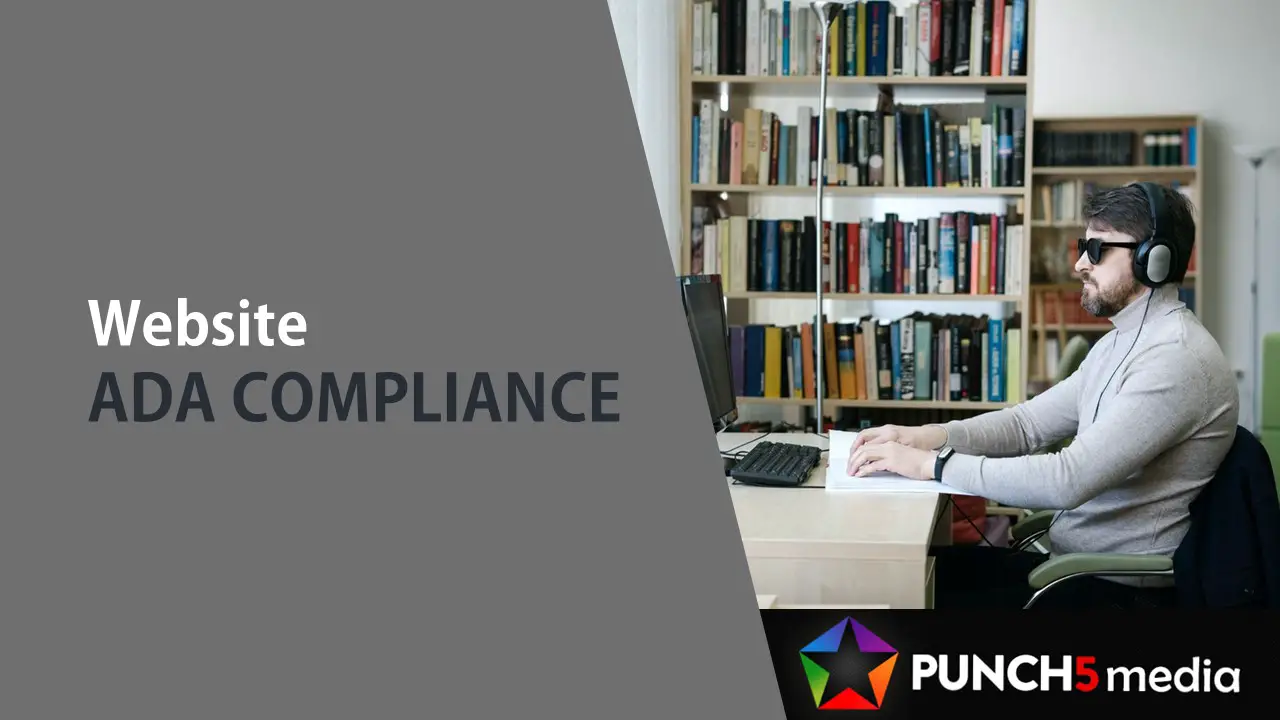ADA Compliance for Websites – Easy 9 Step Checklist
ADA compliance refers to the Americans with Disabilities Act, which is a set of laws designed to protect the rights of people with disabilities.
The act, which was passed in 1990, prohibits discrimination against people with disabilities in a variety of settings, including employment, transportation, public accommodations, communications, and access to state and local government services.
Specifically, when it comes to websites, ADA Standards for Accessible Design passed by the U.S. Department of Justice in 2010, means that your site must be accessible to everyone, regardless of their ability or disability. This includes people who are blind, deaf, or have other physical or mental impairments requiring assistive technologies. In other words, your website must be usable by everyone in order to avoid discrimination.
A common misconception is that ADA compliance is only required for government websites. However, this is not the case. The ADA applies to all websites owned by businesses and non-profit organizations with at least 15 full-time employees that operate 20 or more weeks per year. In addition, those that fall under the category of “public accommodations” must also comply with the ADA. This includes businesses such as hotels, restaurants, banks, retail stores, doctor’s offices, public transportation and others.
Table of Contents
Why Should a Website be ADA Compliant?

Websites need to be ADA compliant for the same reason that all other public accommodations need to be accessible to people with disabilities: it’s the right thing to do. Discrimination against people with disabilities is wrong, and making your website accessible ensures that everyone has an equal opportunity to access your content.
In addition to being the right thing to do, there are also some practical reasons to make sure your website is ADA compliant.
- It will help you avoid potential lawsuits. The Americans with Disabilities Act is a civil rights law, and as such, it gives individuals the right to file a lawsuit if they feel they have been discriminated against. While there are a number of defenses you can raise if you are sued, it’s much easier and cheaper to avoid a lawsuit altogether by making sure your website is accessible to everyone.
- ADA compliance can help you expand your customer base. By making your website accessible to people with disabilities, you’ll be able to reach a larger audience and tap into a customer base that might otherwise be unavailable to you. Don’t underestimate the power of minority groups – they wield a lot of buying power and can be very loyal customers.
- ADA compliance is simply good business practice. In today’s world, consumers are increasingly interested in doing business with companies that are socially responsible. By making your website accessible to everyone, you’ll be able to show potential customers that you care about their needs and that you’re committed to inclusivity.
- Website ADA compliance can potentially improve your search engine ranking. Websites that are accessible to people with disabilities tend to be more user-friendly overall, and this is reflected in their search engine rankings. This is because search engines like Google give preference to websites that provide a good user experience.
Apart from the simple moral reason to make your website ADA compliant, making your website ADA compliant is just good for business. Making your website accessible to everyone will help you reach a larger audience, avoid potential lawsuits, and improve your search engine ranking – all of which can lead to more customers and more revenue for your business.
How to Make a Website ADA Compliant?
The ADA itself does not provide specific guidelines on how to make a website compliant. However, World Wide Web Consortium (W3C) has created the Web Content Accessibility Guidelines (WCAG) which is an international standard for website accessibility.
The WCAG provides a detailed list of technical requirements for making a website accessible, and while it is not required by law, many organizations have adopted it as the standard for determining whether a website is compliant with the ADA.
WCAG compliance is divided into three levels of accessibility: A, AA, and AAA. Level A is the most basic level of accessibility, and Level AAA is the most advanced. The vast majority of websites should aim for Level AA compliance.
WCAG 2.1
The latest version of WCAG 2.1 defines 4 principles of accessibility encompassing 13 guidelines. The 4 principles are Perceivable, Operable, Understandable and Robust. Each of these 4 principles covers a specific domain aimed at making content accessible to people with disabilities.
1. Perceivable
Information and user interface components must be presentable to users in ways they can perceive.
Guideline 1.1: Provide text alternatives for any non-text content so that it can be changed into other forms people need, such as large print, braille, speech, symbols or simpler language.
Guideline 1.2: Time-based media: Provide alternatives for time-based media.
Guideline 1.3: Create content that can be presented in different ways (for example simpler layout) without losing information or structure.
Guideline 1.4: Make it easier for users to see and hear content including separating foreground from background.
2. Operable
User interface components and navigation must be operable.
Guideline 2.1: Make all functionality available from a keyboard.
Guideline 2.2: Provide users enough time to read and use content.
Guideline 2.3: Do not design content in a way that is known to cause seizures.
Guideline 2.4: Provide ways to help users navigate, find content, and determine where they are.
Guideline 2.5: Make it easier for users to operate functionality through various inputs beyond keyboard.
3. Understandable
Information and the operation of user interface must be understandable.
Guideline 3.1: Make text content readable and understandable.
Guideline 3.2: Make web pages appear and operate in predictable ways.
Guideline 3.3: Help users avoid and correct mistakes.
4. Robust
Content must be robust enough that it can be interpreted reliably by a wide variety of user agents, including assistive technologies.
Guideline 4.1: Maximize compatibility with current and future user agents, including assistive technologies.
These are all broad guidelines, and meeting all of them is necessary to be fully compliant with the ADA. To help get started, I’ve put together a more specific checklist of ADA compliance for websites containing the easiest things you can do coupled with the most common accessibility issues they fix.
10 Step Checklist to ADA Compliance
So how do you actually make your website compliant? If you know how a website is created then you’ll also know that it’s easier by far to design an accessible website from scratch than to try and retrofit an existing one, but even if you have an existing site, there are still plenty of things you can do to make it more accessible. Below are some of the most common things you can do to make your website more accessible.
1. Use descriptive alt text for images
When adding images to your website, always include alternative text (alt text) that describes what is in the image. This is important for two reasons: first, it allows people with visual impairments to understand what is in the image, and second, it provides context for search engines, which can help improve your website’s search engine ranking.
2. Use headings and labels wisely
Use headings and labels to organize your content in a way that is easy to understand. This makes it easier for people to skim your content and find the information they are looking for.
3. Use easy-to-understand language
Avoid jargon and abbreviations, and use clear and simple language whenever possible. This will make your content more accessible to a wider audience, including people with cognitive disabilities.
4. Make your website navigable
Your website should be easy to navigate, with a logical structure that is easy to understand. Use clear and descriptive links, and make sure your website has a search function.
5. Use color wisely
When using color on your website, use high contrast colors that are easy to read. This is especially important for people with visual impairments.
6. Give users control over time-based media
If your website includes any time-based media, such as video or audio, make sure to provide controls that allow users to pause, stop, or adjust the volume.
7. Provide transcripts for audio and video content
In addition to giving users control over time-based media, you should also provide transcripts of audio and video content. This will make your content more accessible to people with hearing impairments, as well as people who are not native English speakers.
8. Design forms carefully
When designing forms, make sure the labels are clear and easy to understand. Use input fields that are large enough to be easily readable, and provide instructions on how to complete the form.
9. Use captions and descriptions for video content
If your website includes video content, make sure to provide captions and descriptions that accurately describe the video. This is important for people with hearing impairments, as well as people who are not native English speakers.
10. Test your website regularly
When testing your website, pay special attention to accessibility. Use a screen reader to test your website’s alt text and other accessibility features. You can also use online tools, such as the WAVE Web Accessibility Evaluation Tool, to check for common accessibility issues.
Checklist Summary
Making sure your website is ADA compliant can seem like a daunting task, but it’s important to remember that you don’t have to do it all at once. You can start by making small changes to your site, such as adding alt text to your images or creating transcripts for your videos. Even these small changes will go a long way in making your website more accessible to everyone.
Making your website accessible is important not only for compliance with the Americans with Disabilities Act, but also for making your website more user-friendly for everyone. By following the tips above, you can make your website more accessible and ensure that it meets the needs of a wide range of users.
What Are Some Common Accessibility Issues?
It may not seem obvious to someone without a disability, but websites can be inaccessible in many ways. Here are some of the most common accessibility issues that can make a website difficult or impossible to use for people with disabilities:
1. Images without alt text
2. Links without descriptive text
3. Videos without transcripts or captions
4. Forms that are difficult to understand or use
5. Navigation that is difficult to use
6. Content that is difficult to understand
7. Lack of color contrast
8. Time-based media without controls
9. Lack of transcripts for audio and video content
10. Poorly designed forms
These are just some of the most common accessibility issues that can make a website difficult to use for people with disabilities.
People can have a wide range of disabilities, including blindness and low vision, deafness and hearing loss, learning disabilities, cognitive limitations, limited movement, speech disabilities, photosensitivity and more. On top of that, people can have different combinations of disabilities and trying to use a website that is not accessible can be a frustrating experience.
For people with disabilities, even a small accessibility issue can make the simple task of using a website a nightmare.
For example, someone who is blind might not be able to use a website if it doesn’t have alt text for its images. And someone who is deaf might not be able to use a website if it doesn’t have transcripts or captions for its videos.
These disabilities might seem to be rare, but they are all more common than you might think. According to the World Health Organization, about 15% of the world’s population lives with some form of disability and this means that, for many people with disabilities, just using the Internet can be a daily struggle.
How Can You Make Sure Your Website Is ADA Compliant?
There are a few different ways that you can make sure your website is ADA compliant. These include:
1. Use an Online Tool
The best way to ensure that your website is ADA compliant is to use a web accessibility tool to check for common accessibility issues and then make the necessary changes to your site.
There are a number of different web accessibility tools available, but one of the most popular is the WAVE Web Accessibility Evaluation Tool. This tool will automatically check your website for common accessibility issues and provide you with a report of any problems it finds.
2. Hire a Website Compliance Consultant
There are a number of consultants who specialize in website ADA compliance and can work with you to review your site and make recommendations to ensure your website meets all the requirements.
These consultants can be expensive, but they can be a valuable resource if you want to make sure your website is accessible to everyone.
3. Get Feedback From People With Disabilities
One of the best ways to ensure your website is accessible is to get feedback from actual people with disabilities who try to use your site.
This can be done by directly asking people with disabilities to review your site and provide feedback or by reaching out to organizations that work with people with disabilities.
This process will help identify any accessibility issues with your site as well as get ideas on how to improve the experience for people with disabilities.
Are There Any Penalties for Not Having an ADA Compliant Website?
Yes, there are a few different penalties that you could face if your website is not ADA compliant. These include:
- Fines from the Department of Justice
- Loss of business due to inaccessible website
- Damage to your reputation as a business that is not inclusive or welcoming to all
- Lawsuits from people who were unable to access or use your website because it was not ADA compliant.
It’s important to note that these penalties could vary depending on the severity of the offense and whether or not it was intentional. If you are found to be in violation of the ADA, you may be required to make your website compliant within a certain timeframe. Failure to do so could result in further penalties.
ADA compliance is necessary for any business that wants to ensure their site is accessible to everyone. By following the tips above, you can make sure that your website is compliant with the ADA and avoid any potential penalties.
FAQs
What is the difference between ADA compliance and WCAG compliance?
ADA compliance and WCAG compliance are two different things.
ADA compliance is compliance with the Americans with Disabilities Act, which is a US law that prohibits discrimination against people with disabilities.
WCAG compliance, on the other hand, is compliance with the Web Content Accessibility Guidelines, which is a set of international guidelines for making web content accessible.
While WCAG compliance is not a legal requirement, it is generally seen as the best way to make your website accessible to people with disabilities.
If your website is conforms to everything in WCAG 2.1 then it will also be compliant with the ADA.
Wrap Up
ADA compliance can help to make the Internet a more accessible place for everyone. Remember that everyone deserves to have equal access to your content and by taking the time to ensure that your site is accessible, you are helping to create a more inclusive world for all.
People with disabilities often use assistive technologies to help them access the web. These can include screen readers, which read aloud the text on a website; screen magnifiers, which make text and other content larger; voice recognition software, which allows people to control their computers with their voices; and more. It is important to design your website in a way that is accessible to all users, including those using assistive technologies.
Software like JAWS helps blind and low vision users to access the internet by reading aloud the text on a website. But if a website is not designed with accessibility in mind, it can be difficult even for the software to interpret the content correctly. This can make it hard for users to access the information they need.
If you have a suggestion to improve this article please comment it below.



